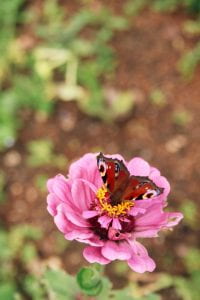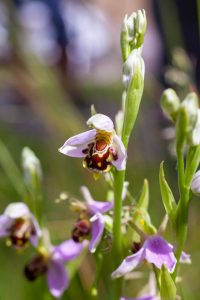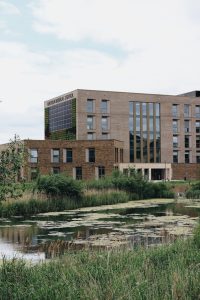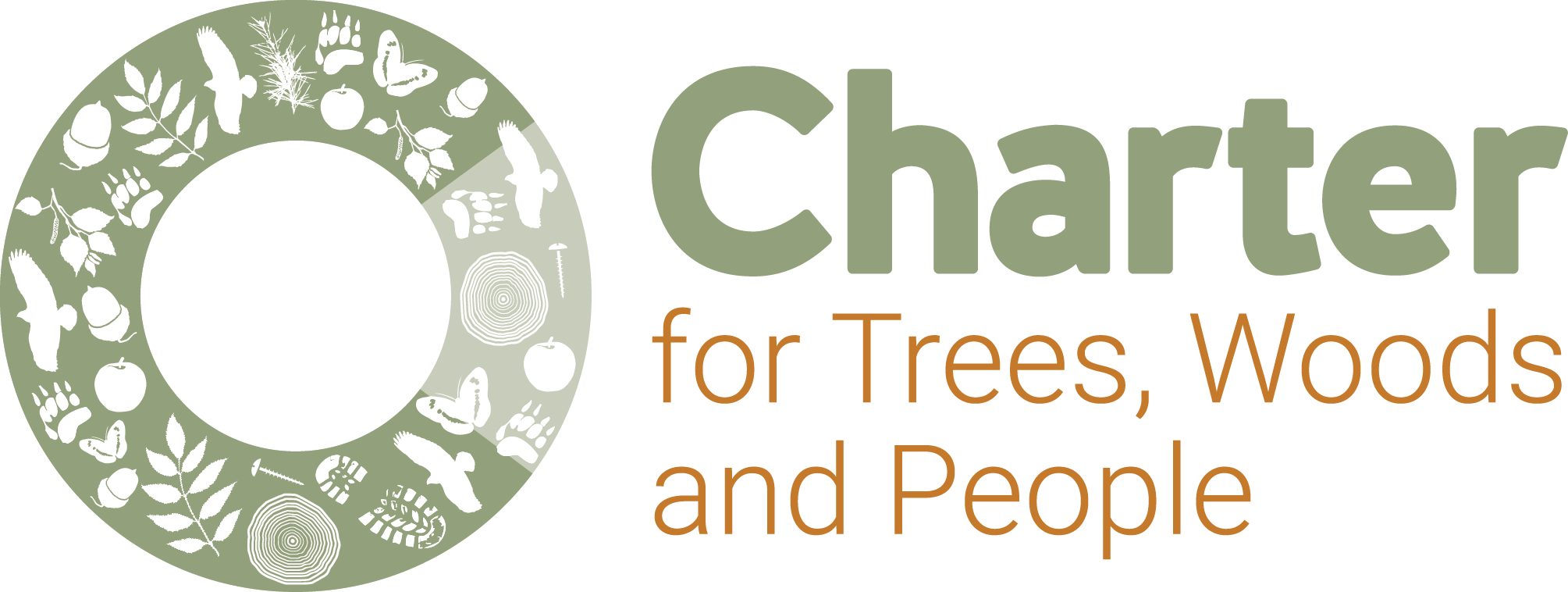The University has a commitment to manage and protect the biodiversity assets on our estate. The University’s Environmental Policy includes a commitment to monitor the biodiversity value of the estate and since 2012 we have had a specific Biodiversity Policy. Read our policies: Policies Webpage
For Nature, for People
Our 2030 Biodiversity Action Plan is in progress, and we look forward to sharing more on our commitment to a Nature Positive future at the University of Lincoln.
We are a Nature Positive University
An alliance of over 117 universities from 48 countries committing to being “Nature Positive” was officially announced this year at the COP15 Summit in Montreal.
The University of Lincoln, UK, is proud to be one of the founding universities of the Alliance and has committed to the maintenance and development of its natural spaces, including looking after biodiversity.
The Nature Positive Universities Alliance, led by Oxford University and the United Nations Environment Programme (UNEP), is a global network of universities that have made the pledge to work towards a nature-positive goal to halt, prevent and reverse nature loss by addressing their own impacts and restoring ecosystems harmed by their activities.
As part of our pledge, we have conducted baseline surveys across our estate. Our targets and actions can be viewed in our draft Biodiversity Action Plans below. These plans have been approved by our Environmental Sustainability Group, but we are also asking for comment from our university community and external stakeholders via our survey below. This will remain open until January 2024.
Progress will be reported on in our Annual Sustainability Reports.
Read more about what it means to be a Nature Positive University via the button below.
View our 2023-24 Biodiversity Action Plan:

Have your say on our plans:

The future of biodiversity
As of June 2023, Biodiversity Net Gain Surveys have been completed for the Estate. Following review of these surveys, our Biodiversity Net Gain Working Group will be actioning our Biodiversity Action Plans that will help steer us to a nature positive future. We are continuing to work with local stakeholders to improve biodiversity across Lincoln and beyond, partnering with the East Mercia Trust on the Greening the Brayford project, supporting Wilder Connections at Doddington Hall & Gardens, and the Lincoln City Council “Greening the City” project.
About our Estate
The University of Lincoln is split over three campuses, Brayford, Riseholme Park and Holbeach. Our Riseholme Park Campus is set in the countryside with grounds that have established woodland and wildlife.
There are a variety of green space specific projects ongoing on our Estate at present. They include:
- Brayford Kitchen Garden
- Estates Rewilding
- Farming for Carbon & Nature at Riseholme Park Farm
- Ross Lucas Medical Sciences Building Wildflower Meadows
- Peace Garden – managed by the Chaplaincy
- Alfred Tennyson Building Sky Garden – managed by Student Wellbeing
- Hedgehog Friendly Campus
- Joseph Banks Laboratories Wildflower Meadows
- Observation Hive (the Brayford bees)
- No Mow May
Get Involved
You can take part in the following activities to monitor the biodiversity at the Brayford Pool campus:
- Swan Watch – Researchers at the University of Lincoln have launched a new project appealing for help from the public to collect data on Lincoln’s iconic swan population. Members of the public can register to download an app (Epicollect5) and log their own sightings of swans in and around Lincoln. More information here: Help Researchers Learn More About and Protect Lincoln’s Iconic Swans
- University Birdwatch Challenge – record how many birds you can see around campus
- Biodiversity Index – a mapping project to record habitat types

Michael Teague and Grace Kidman, 2024/2025 Nature Positive Universities Student Ambassadors, pose with newly installed bug hotels.
- Nature Positive Universities Student Ambassadors – Each year there is the opportunity to sign up to be an NPU Ambassador, experience being part of a global network and help coordinate biodiversity events in real time during your studies. Please do contact us about these positions.
- University Mammal Challenge – Student teams of five can sign up the National Mammal Society Challenge each year which runs between February April. This is a truly fantastic opportunity to survey wildlife and compete against other universities.
For more information on these schemes, email environment@lincoln.ac.uk. Additionally, you can get involved in any of the environment volunteer activities hosted by the SU, or you can get out into the community and help RiverCare with their Community Clean Up programs.
A Sustainable Campus
Brayford Pool
The Brayford Pool campus is located in the heart of the city centre and is an urban area. However, the site has considerable importance for biodiversity. The site is surrounded by waterways (River Witham, Brayford Pool, Foss Dyke, Delph Drain etc.) which act as green corridors – supporting the movement of wildlife through the city centre. The University has conducted a number of surveys on the biodiversity value of the campus and these have shown that the site supports some locally important aquatic plants. 
The site also hosts a wide variety of bird species, including kingfishers, house sparrows, pied wagtails, moorhen, coot, mute swan and sparrowhawks. Animals that have been seen on campus include roe deer, hedgehogs, grass snakes, bats, common lizards, common newts, foxes, and grey squirrels. In recent years, a pair of mating otters have been spotted in the Brayford, it is believed that these are the pair released in the River Trent who made their way down the Foss Dyke and have now made a home in the area.
East Mercia Rivers Trust: Greening up the Brayford:
Over two sunny days in March 2022 the next phase of ‘greening up’ the Brayford Pool began. With generous funding from Environment Agency, Anglian Water’s Cambridgeshire Community Foundation and the City of Lincoln Council, East Mercia Rivers Trust set about adding a further 80m of floating islands along the concrete walls of the UK’s oldest inland harbour.
Biomatrix Water were employed to design and build the floating ecosystems and, with the help of some enthusiastic volunteers, these were planted them up with hundreds of aquatic plants before launching them into the pool where the Biomatrix team secured them to the harbour walls.
This project not only provides more important habitat for wildlife but, once the plants are established, will also enhances the aesthetics of the area adding colour and much-needed greenery.
Swans, geese, cormorants and other waterfowl are already using these for nesting and resting. It is hoped that our local otters will also use them.
Riseholme Park
The Riseholme Park campus is an area of landscaped parkland, woodland and agricultural fields around two miles to the north of the centre of Lincoln. It has a number of important habitat areas and protected species – including great crested newts, badgers and water voles. 
There are several projects running at the campus to encourage biodiversity.
- Wildflower meadow management – a project investigating the use of mowing as management of wildflower meadows
- The butterfly garden – a small garden encouraging butterflies as pollinators
- “Tall Thrift” wildflower conservation – a community project in collaboration with the Lincolnshire Wildlife Trust in propagating tall thrift wildflowers
Wildflowers for wildlife
From June 2020, we’ve left some grassy areas on the Brayford to grow long to provide respite for birds and insects. These include: 
- The bank behind the Stephen Langton Building
- The grass surrounding the Delph Pond
- The Kitchen garden
Wildflowers that have been seen in these areas include poppies and Bee Orchids. Bee orchids(opens in a new tab) (Ophrys apifera) can be found in the Kitchen Garden behind Witham House and have previously flowered around the Delph Pond on the Brayford Pool Campus. These areas are managed with support from our Landscaping team.
A Wildflower Meadow is managed separately behind the Joseph Banks Laboratories.
A Hedgehog Friendly Campus
In 2019, we were one of the first universities in the country to join the Hedgehog Friendly Campus initiative. We want to make our campus hog-friendly, through the education of how you can help hedgehogs, joining in and promoting national campaigns such as Hedgehog Awareness Week and by making the environment in which they live as safe and welcoming as we can. 
Since then, we’ve gone on to achieve the Bronze, Silver, and most recently Gold award. We are one of the first universities in the country to reach this level of the campaign and are thrilled to be helping hedgehogs in our city.
You might be wondering what a Hedgehog Friendly Campus looks like, you can find out more on our project page below:
Delph Pond
Did you know that the Delph Pond, located outside the Isaac Newton Building, is an integral part of Lincoln’s flood defences? It has the capacity to store surface water in the event of a flood, however due to silt build up it does need to be dredged every 5-8 years. It takes water from both sides of the railway line using the gullies under the railway line which bring water from the Brayford North into the Delph Pond. 
Twice a year, the vegetation around the edge of the water is cut back. The Internal Drainage Board, who own and manage the Delph Pond, do this to enable access to the pond and dredge it. This removes excess silt and ensures the water can flow freely through the channels across campus and store surface water in the event of a flood. Whenever the foliage is cut back, the Drainage board work with the University to ensure that species living there aren’t affected.
The Delph Canal links up to the ponds by the hockey pitch, behind the 5-aside pitches and the Pavillions; it also goes back under the railway line and up to the pumping station at the Pyewipe.
Tree Charter
The University of Lincoln has been a member of the Woodland Trusts Tree Charter since 2017, when we launched our edible campus project (now the Kitchen Garden). We planted several apple trees across campus and continue to prioritise positive management of our woodland across the estate, including recording notable trees through the Ancient Woodland Inventory.
Learn more about Ancient Woodland.
Learn more about the Tree Charter.


